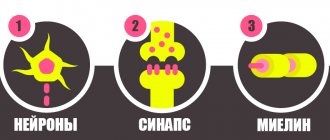The essence
The main reason is the discrepancy between social and everyday circumstances and the child’s changing needs. He wants to be an adult, he even feels like one. However, a huge number of restrictions, rules and demands from parents do not allow him to fully demonstrate independence. This causes an internal protest, which results in emotional and behavioral deviations that frighten parents so much.
The three-year crisis is characterized by the following mental neoplasms:
- primary independence;
- a new level of self-awareness;
- establishing interpersonal contacts, building new, more complex social relationships;
- volitional regulation of activity.
Developmental psychology helps to understand what is happening to a child during this period. It allows you to understand the factors that aggravate or alleviate the crisis, and gives recommendations on how parents should behave in order to prevent negative consequences.
Educational program. You can learn in detail about this period from special literature on psychology: Vygotsky “The Crisis of Three Years”, Guskova “Features of the Crisis of 3 Years in the Mental Development of a Child”, Vasilkina “What to Do if a Child Has a Crisis of Three Years?”, Abrosimova “The Age of Obstinacy. About the crisis of three years”, Filicheva “The baby is three years old”.
How does it feel from the inside
The feelings of the person himself are quite difficult to describe, primarily because such people rarely recognize their condition as abnormal.
The internal state will be characterized by an extreme degree of confusion in one’s own desires and needs, conflicts with oneself, and sometimes self-aggression.
The passive form in this case can be felt as inhibition of consciousness, an extreme degree of indifference towards all surrounding things and people.
Causes
The main reason why children experience a crisis at age 3 is the desire for independence. By this age, they already speak well and can clearly and clearly express their desires and emotions verbally. It seems to them that this is enough to be the same as adults: eat what they eat, sit late at night watching TV, swear in bad words. Every action in this little domestic apocalypse will be aimed at achieving independence.
However, the 3-year-old crisis occurs differently for each child. Someone makes the existence of the family unbearable - endless hysterics, uncontrollable aggression, constant protests, complete depreciation of previous rules lead to serious problems. For others, the manifestations are not so vivid: isolated cases of obstinacy, sudden changes in mood, minor whims. It is noticeable that a crisis has arrived, but it is completely controllable. There are also children for whom everything goes smoothly and almost unnoticeably.
Psychologists identify a number of reasons for the intensity and brightness of the crisis of 3 years.
Authoritarian parenting style
If excessively strict norms are established in the family, unconditional submission is required, will and independence are suppressed, this results in prolonged hysterics.
Overprotection
Excessive parental care, like an authoritarian parenting style, suppresses will and independence. A child, even at 3 years old, is considered unintelligent, unviable and completely helpless. They do not allow him to take a single step without the permission of an adult. It is not surprising that the baby will prove the opposite, which will significantly complicate the problem period.
Society
The situation is often complicated due to the authoritarian parenting style or the elementary rudeness of the kindergarten teacher. The company of children with whom he plays in the yard or in kindergarten can have a bad influence on a child. Conflicts with other people force him to defend his independence even more zealously.
Intrafamily relations
The crisis is aggravated if there is a tense atmosphere within the family. Firstly, if the parents often fight or are in a state of divorce. The second psychotraumatic situation is that they are constantly busy at work and have no time to take care of the child. Problems may begin after the birth of the second baby. Childhood jealousy arises, which turns into uncontrollable outbursts of anger. In all these cases, there is a lack of attention.
But older children who participate in upbringing make the crisis easier.
Temperament
An unstable nervous system, excessive impressionability, choleric or melancholic type of temperament is another reason for the worsening crisis of 3 years.
Health status
In healthy children, the crisis period proceeds within normal limits. He is noticeable, but is kept under control by his parents. If a child develops mental abnormalities and disorders by the age of 3, the situation worsens, the manifestations are uncontrollable, vivid and explosive. In the presence of chronic diseases, genetic pathologies, or physical disabilities from birth, children are usually strongly attached to their mother and do not rebel against her. Therefore, they most often do not cause much trouble.
Adaptation to kindergarten is often cited as one of the main reasons for the 3-year-old crisis. Indeed, it is at this age that parents usually send their child to this preschool institution. But there are also children who are assigned there much earlier (from 1.5 or 2 years old). There are kids who don’t go there at all; they stay at home with their mother or grandparents. According to research, in all these cases, by the age of 3, an age crisis occurs, regardless of whether the child attends kindergarten or not and from what age.
Signs
Parents need to know how the 3-year-old crisis manifests itself in order to distinguish its symptoms from ordinary contextual situations. For example, if a child refuses to go to bed on time, this may be dictated by the fact that he was overexcited before bed, played too many noisy games, or sat in front of the TV for too long. Each case must be considered separately.
Psychologists call the complex of symptoms of a 3-year crisis “seven stars.”
Negativism - “I’m doing it out of spite!”
They give up their own desires that coincide with the demands of their parents. They don’t want to do something just because the initiative comes from an adult. A negative reaction is always targeted and directed not at the content of the request, but at a specific person. For example, a mother calls her child from the street for lunch. Despite the fact that he himself has been hungry for a long time and wants to go home, he refuses to do this just for the sake of confronting his mother.
Obstinacy - “I don’t want to obey!”
Unlike negativism, this manifestation of the crisis is impersonal. It is aimed at the everyday life and daily routine that parents try to accustom their baby to. He refuses to go to bed at the right time or put away his toys.
Stubbornness - “I decided so!”
"Don't want!" and I will not!" without any explanation - the most common signs of a 3-year crisis. Neither persuasion nor threats can overcome them.
Riot (protest) - “I’m tired of everything!”
Similar to previous manifestations of the crisis. However, rebellion is the most terrible of them. Firstly, it includes negativism, obstinacy, and stubbornness. Secondly, it is permanent. The child refuses breakfast or nap every day. Thirdly, it manifests itself most clearly. It comes to uncontrollable outbursts of anger and real hysteria. This is fraught with severe stress and auto-aggression.
Despotism - “Do as I want! I am the master and master!”
They try to manipulate parents with hysterics and tears. This especially affects mothers and grandmothers. They are capricious, scream and even roll demonstratively on the floor, just so that the desire is fulfilled (they bought a toy, let them go for a walk, gave them candy).
Devaluation - “I don’t love you! You are bad!
They are angry at what is dear to them, trying to get rid of addiction. A quiet, well-mannered child may start screaming and behave badly in front of strangers (in public transport, for example). They break their favorite toys. Mom becomes enemy No. 1, they stop listening to her and may even hit her.
Willfulness - “I can do it myself!”
This should not be confused with the desire for independence. It’s one thing when a child tries again and again to tie a shoelace or scramble an egg in a plate, but at the same time he listens to the advice of adults and does not refuse help. And it’s completely different when he gets angry, doesn’t listen to anyone, does everything wrong, pushes his parents’ hand away. This often ends in sad situations: household appliances are turned on without permission, valuables are damaged, a child goes far from home.
These are the main symptoms of the 3-year crisis, which manifest themselves regularly, quite clearly, and most often in a complex manner. They may be accompanied by other emotional and behavioral abnormalities. The latter are not observed in everyone and not always, but they can aggravate and prolong the course of the crisis. These include:
- distance from parents who lose the child’s trust and may even cease to be an authority for him;
- greed: like adults, children want to have something of their own, and they fiercely guard their property;
- harmfulness is the basis of obstinacy, stubbornness and negativism, often due to a hereditary character trait;
- jealousy: the child demands the attention of a loved one 24/7 and does not want to share it with anyone else;
- unreasonable aggression: at 3 years old, the baby still does not understand what is happening to him, and blames others for all his troubles, which leads to fights, scratching, biting.
Parents must understand that for each child the crisis manifests itself differently, but it happens anyway. For some it is smoother and more calm, for others - with daily violent protests and hysterics. If symptoms are not observed before age 4, it is necessary to consult a psychotherapist because this may indicate a developmental delay.
This is interesting. In psychology, a child experiencing a crisis period of 3 years is compared to a novice driver. At first, after passing the exams and obtaining a license, the newly minted driver is careful, follows all the rules, does not exceed the speed limit, and consults with experienced drivers. But he soon gets used to it, which dulls the feeling of fear: he begins to drive recklessly, tests the capabilities of his car, and tries to express himself as boldly as possible behind the wheel. The baby behaves exactly the same way. Until the age of 3, he watches and gets used to it. And then he tries to realize himself and assert himself through protests and violation of all requirements and rules.
Active and passive form of resistance
It is customary to distinguish two main forms of negativism: active and passive.
Passive negativism is expressed in absolute ignorance of demands and requests. In the active form, a person shows aggression and sharply resists any attempts to influence him. As one of the subtypes of active negativism, we can distinguish paradoxical, when a person does everything intentionally the opposite, even if it is at odds with his real desires.
Separately, there are purely physiological manifestations of this condition, when a person refuses to eat, practically does not move, and does not speak.
Deadlines
Parents faced with a 3-year crisis are primarily interested in how long it lasts and when it should normally end. However, this question is too individual to have a clear answer.
Firstly, it can begin at 2.5 years or at 3.5. Psychologists say that the sooner a child is sent to kindergarten, the sooner a crisis occurs. The main thing is that this happens before the age of 4 - then we can talk about the norm of mental development.
Secondly, it can end within 3 months, or it can last up to one year. This depends on the stability of the nervous system, the child’s temperament, the behavior of the parents and outside psychological help.
Thirdly, a short-term crisis period is most often accompanied by bright appearances, while a protracted period is accompanied by calmer ones. This is the norm. But if it lasts more than six months and uncontrollable hysterics occur annually, a consultation with a psychotherapist is mandatory.
Why is it important not only to know, but also to be able to distinguish symptoms?
If parents know what awaits them during the three-year crisis, it will be easier for them to cope with it. Many adults do not even suspect what awaits them .
Therefore, they perceive negativism, despotism, stubbornness and other manifestations simply as bad behavior. They scold the child and try to change him. And this is fundamentally wrong.
How parents behave during one of the most difficult periods for a child will largely affect his future life. This will be especially noticeable in adolescence, because the mechanisms for overcoming such situations are the same.
What to do
Advice from a psychologist will help parents cope with the 3-year-old crisis.
The most important recommendation is to respect the child’s independence. Allow him to perform some basic actions himself. At the same time, prohibitions must also work, which are strictly forbidden to be violated (possing something into a socket, turning on the iron, taking money, biting). By the age of 3, he should already have feasible household responsibilities. He can clean up toys after himself, wipe off dust, and set the table. Yes, his participation will slow down the process, but believe me: it's worth it. This will make him feel independent and needed. This means that the need to prove your adulthood and independence will automatically disappear.
Additional recommendations:
- Keep calm. Be patient.
- At the moment of whims, switch attention to something else, interesting: watch your favorite cartoon, take a walk, treat yourself to candy. Use gaming techniques.
- Sometimes give the right to choose in minor everyday situations: which cartoon to watch, which fairy tale to read, which juice to drink.
- Scold and punish for some specific action done here and now.
- Analyze what happened. Talk to your child about what he did wrong and why it was bad.
- Adhere to a single parenting style. If mom doesn’t allow you to eat chocolate before dinner, but dad spoils his daughter and allows her to do it, negativity will manifest itself as clearly as possible.
- Show correct behavior by example. Children aged 3 are prone to blind copying. You will achieve nothing if you yourself do what you forbid them to do.
- Spend as much time together as possible.
“10 is not allowed”: a reminder for parents
- You cannot insist on immediate fulfillment of a requirement (request). It is better to let the baby cool down and try again after some time.
- You can't give in to manipulation. Don’t satisfy your child’s every whim just because he’s throwing tantrums—just ignore them.
- You can’t hang “labels”: greedy, boring, harmful.
- You can't physically punish.
- You can't shout.
- You cannot force your help.
- You cannot compare a child with other children.
- You can't give orders.
- You cannot enter into arguments or bickering.
- You cannot use complex terms and categories in a conversation that the child does not understand. For example, appeal to conscience or honor.
There is information about the 3-year crisis in the works of L. S. Vygotsky. But they are more scientific in nature, contain many terms and explain all phenomena from a purely psychological point of view. This period is presented more accessible by Dr. Komarovsky. His thematic videos can help parents overcome children's protests.
3 tips from Dr. Komarovsky
Minimum prohibitions
If a child hears the words “no” and “no” from adults too often, this greatly outrages him, and protest grows inside. He needs at least some partial freedom. Constant prohibitions from all sides infringe on him during such an important period of primary maturation and cause psychological trauma. “You can’t” should be said extremely rarely, but at the same time demand unquestioning compliance. This should be a safe word, a danger signal. This is the only way the baby will realize its importance.
Unified parenting style
Komarovsky pays close attention to this. "No!" All family members should tell the child about the same action: parents, grandparents, uncles and aunts, older children. Otherwise, there will be no awareness of the ban, which will aggravate the crisis.
Persistence of prohibitions
The list of prohibitions should be permanent and not change. If today a child is allowed to stay out late, it is useless to demand that he go home on time tomorrow, according to the schedule.
Corrective role-playing games
"Shop"
The child is in the role of a seller. The parent controls the favorite doll, which in this situation is the buyer. She is capricious, throws everything around, cries, screams, rolls on the floor, demands to give her the goods without money. The child must not only see from the outside how terrible this behavior looks, but also recognize himself in the toy. It is allowed to conclude at the end of the game: “You behave the same way. Do you really think that's good?".
"Family"
Any number of people can play. The child is in the role of one of the parents. His task is to put his baby (this can be any toy or one of the adults) to sleep or feed him. If the game is played in the first half of the day, you can play out the same situation as in the “store”: whims, hysterics, tears. If it’s already late afternoon, everything should be quiet, peaceful, calm. Let him sing a lullaby, tell a fairy tale, shelter him, talk tenderly. As a result, this will have a calming effect on him. He himself will fall asleep faster when the time comes.
"Storytellers"
Parents and their children compose fairy tales, the plot of which is similar to what they live every day. For example, the princess refused to eat semolina porridge in the morning. Because of this, she quarreled with her father-king, he got angry and locked her in a high tower, in which she had to languish without walks and her favorite toys. Or a naughty bunny who ran far into the forest from his mother, got lost, and was almost eaten by a gray wolf. There is no need to draw specific analogies with the child; conclusions, as in the “shop” game, are not drawn. He himself must understand the meaning of the fairy tale and say why such misfortunes happened to its heroes.
View from the outside
If we talk about a psychiatric term, then in this case negativism itself acts as a symptom of a certain number of diseases. Moreover, depending on the form (active or passive), it can manifest itself both in demonstrative insubordination and in passive resistance to any requests of the doctor, which is its most important feature in this case.
As for negativism from a pedagogical or general psychological point of view, the main external manifestations in this case will be speech and behavioral signs:
- difficulties with communication, interaction with others, even the closest people;
- conflict;
- refusal to compromise;
- skepticism and mistrust bordering on paranoia.
In the case of adults, negativism and nihilism should not be confused. Nihilism is a worldview position, and, despite the fact that its external manifestations are similar to those of negativism, it is a conscious choice of a person, while people with pathological stubbornness behave this way unconsciously.
Professional help
If parents are unable to cope with the manifestations of the crisis on their own, they should seek help from a specialized specialist. For starters, it could be a child psychologist. What warning signs indicate such a need:
- fear of independence and refusal of it;
- detachment from parents;
- tendency towards sadism;
- too frequent and prolonged tantrums;
- emotional and behavioral deviations characteristic of the 3-year-old crisis affect the physical condition.
In case of intense, frequently recurring hypobulic seizures (hysterics or convulsions), the child is referred to a neurologist who conducts a physical examination. It evaluates reflexes, sensitivity, coordination, muscle strength and tone. This is necessary for the differential diagnosis of a crisis with neurological diseases.
If a neurological or mental disorder is diagnosed, a course of treatment is prescribed with the use of pediatric sedatives and other treatment methods. In their absence, a psychocorrection program is implemented to overcome the crisis. It usually consists of the following steps:
- Working with parents: explaining to them the essence of the 3-year-old crisis and recommendations on how to behave.
- Working with factors that aggravate and alleviate the crisis. The former are eliminated whenever possible, and emphasis is placed on the latter.
- Working directly with the child. This can be fairy tale therapy, dance movement therapy, isotherapy, symbol drama, role-playing games, etc.
Usually the matter is limited to 5-6 sessions, as a result of which the child becomes calmer, and parents acquire knowledge of how to behave correctly in critical situations.
What to do if this affects your family?
If it seems to you that one of your loved ones has signs of negativism in behavior, then, first of all, you should contact a psychologist or psychotherapist to resolve the internal problems that caused this condition, since such pathological stubbornness in itself is only a consequence , therefore, in order to overcome it, it is necessary to work with the root cause.
Among the methods of psychotherapy, play therapy, art therapy, fairy tale therapy, etc. are most suitable for preschoolers and primary schoolchildren.
For negative adolescents and adults, cognitive behavioral therapy has proven itself to be the best treatment. It is also important not to forget about your own attitude towards your loved ones. Psychotherapy will be most successful only if you work on this problem as a team.
In order to correct negativistic behavior and, if possible, avoid any conflicts, it is necessary to be creative. This is especially true for children.
It is necessary to exclude any psychological pressure on the child; in no case should there be threats or physical punishment - this will only aggravate the situation. You will have to use so-called “soft power” - negotiate, adapt, make compromises.
It is advisable to generally avoid situations in which conflict may arise.
Your main goal is to ensure that your child begins to follow positive patterns of communication and interaction with others. Don't forget to praise him every time he does something good, makes concessions, helps you, or communicates calmly with other people. In overcoming negativism, the mechanism of positive reinforcement plays a crucial role.
Gender characteristics
When overcoming the crisis period of this age, parents should take into account the gender characteristics of their children.
Girls
By the age of 3, they speak much better than boys, so during a crisis they use their verbal abilities for manipulation. In this they must be immediately limited: clearly define what is permissible to say and what is not.
Girls have well-developed auditory perception, so she needs to say all requests loudly and clearly.
Girls are more emotional, which is why they are the ones who most often throw tantrums and act up during a crisis. Given this psychological feature, parents need to direct their overwhelming emotions in the right direction. For example, delegate some of the household chores, get involved in modeling or drawing.
Boys
By the age of 3, boys cannot always express their overwhelming emotions in words. Therefore, they result in aggression and isolation. To prevent this, talk to your baby every day about what happened, what he feels and what he wants.
Boys have well-developed visual perception, and they ignore half the information. Therefore, it is better to show him everything clearly. Don’t waste time saying “Put the toys away!”, but bring them to them and show them where to put them.
By the age of 3, boys already develop a need to explore the world around them. Therefore, they run around a lot, look into every basement and open hatch, climb trees and fences, put something in sockets, disassemble (= break) household appliances. To avoid injury, parents must clearly define territorial restrictions for them.
Features of negativism in adolescents
Negativism is the main symptom of the teenage crisis. A child who was recently calm and obedient becomes irritable, rude, and withdrawn.
Teenage negativism is a child’s desire to declare to the whole world that he is already an adult and can make his own decisions. When faced with misunderstanding from adults, due to his limited life experience, he simply does not know how to adequately resolve conflicts and defend his point of view with reason. The result is quarrels, grievances “to the whole world,” boycotts of parents and friends. With ostentatious obstinacy and obstinacy, the teenager tries to disguise numerous fears and complexes. [4]
It is important not to leave the child alone with his bipolar world, where only good and evil rule with a complete absence of halftones. Negativism in adolescents goes away as they grow older, accompanied by the accumulation of life experience. With the participation of parents, the child must learn to “negotiate” with himself and look at the world more positively.
Consequences
According to the famous psychoanalyst Erik Erikson, the crisis of 3 years contributes to the formation of independence and strong-willed qualities. And these are not the only positive consequences, among which can also be noted:
- primary independence;
- adequate self-esteem;
- ability of self-analysis;
- social adaptation.
However, with insufficient attention and incorrect behavior of parents, as well as due to the psychological problems of the child himself, the crisis can have negative consequences. Firstly, frequent and too impulsive tantrums can result in injury and cause quite deep stress. Secondly, due to internal experiences and excessive emotional stress, the following often develop:
- neurotic reactions;
- enuresis;
- internal complexes;
- night terrors, nightmares;
- stuttering.
A protracted childhood crisis leads to the formation of a hysterical personality type. Its characteristic symptoms become permanent patterns of behavior.
The age crisis of 3 years is a mandatory stage in the development and formation of a full-fledged personality. It cannot be avoided or cured like any disease. But parents are able to smooth out and minimize the negative consequences. To do this, you will have to be patient and understand child psychology.
Clinical picture and behavioral characteristics of children
Children with motor alalia are distinguished by the following characteristics:
- Preserved intelligence. The child learns normally, understands gestures, recognizes pictures, and recognizes familiar people.
- Incorrect use of voice. Your baby may speak too loudly or too softly.
- Incorrect pronunciation of words and sentences (the child does not speak, but rather babbles), while voiced and soft consonants sound correctly.
- The baby does not respond to questions and finds it difficult to answer.
There is also a more severe form of alalia: with it, the child understands the address, but does not speak at all.
In addition to speech problems, a child may exhibit other typical symptoms, for example, children often experience fatigue, especially during learning. Excessive activity, interspersed with periods of fatigue, is common. Many children experience either severe inhibition or severe disinhibition, depending on the characteristics of the injury.
Important! Alalia does not occur due to stress or difficult life events. Its cause is brain damage, not fear or psychological trauma.










